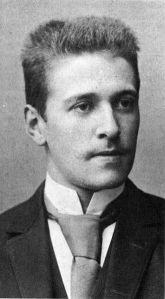
Hugo von Hofmannsthal at 19 in 1893. (Wikipedia.) Click to enlage.
Last time, we looked at a German who was a prominent member of the first generation of poets to write in vernacular German. Hofmann von Hofmannswaldau lived during the greatest physical destruction of Germany (before the twentieth century) but because he was connected with the Austrian victors, he and his poetry were little affected by the catastrophe.
Today we look at an Austrian poet, writing in German, at a time when Austrian cultural traditions were about to unravel, years before Austria would be first dismantled then destroyed by its association with Germany. The time was the late nineteenth century, and the poet was the young Hugo von Hofmannsthal (1874-1929). Both the Baroque and the Late Romantic poems in these two posts deal with transience. (And both, in different ways, are connected to Sigmund Freud.)
Hofmannsthal is known today, if at all, as the librettist of several Richard Strauss operas, notably Elektra and Der Rosenkavalier. The former is a powerful psychological probing of rage-induced madness set to a highly chromatic score; the latter is an acquired taste (one that I have yet to acquire). In his day he was known mainly as a playwright. But Hofmannsthal never saw himself as an entertainer and had no illusions about his popularity. In 1908 (admittedly at the early stages of his stage career) he told an American, “I realize that I write for only about five hundred people in Europe.”1
Before he devoted himself to the stage, Hofmannsthal was the preeminent poet of fin de siècle Vienna.
If fin de siècle Vienna is what is on the other side of a giant wall separating overly refined, highly wrought Romanticism from Modernism, then Hofmannsthal never made it to this side of the wall. He had no interest in making the attempt. In this respect he resembled Strauss, who never ventured into the new music. But Hofmannsthal haled from Vienna, where Klimpt, Kokoschka, Otto Wagner, Schoenberg (at the time Schönberg), Berg and Webern, and others were all at various times and to different extents midwifing modernism. And of course, the man who discovered and interpreted the unconscious irrationality of humanity, the aspect that would form the basis of modernity’s view of us, Sigmund Freud, was just beginning to publish his views at the turn of the century. This collection of cultural radicals produced an intellectual revolution as fundamental as anything since the Renaissance. But Hofmannsthal would not be a revolutionary.
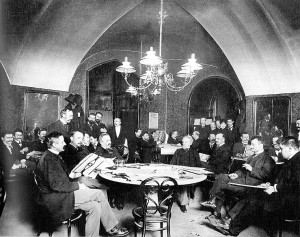
Cafe Giensteidl sometime before 1897. Photograph by Carl von Zamboni for he illustrated newspaper Die vornehme Welt. From collection of Vienna Museum.
It’s even more curious, at first glance, that Hofmannsthal did not join the radicals given that he belonged to something of the literary vanguard, the Jung-Wien (the “Young Vienna” movement). This group of writers of literature and criticism gathered in coffee-houses, under the leadership of playwright and critic Hermann Bahr. The manifesto involved the death of naturalism. Their principal haunt was the Café Griensteidl until it closed in 1897. It was at these meetings that Hofmannsthal met Arthur Schnitzler (who was a member) and Stefan George. After the café closed, the club soon ended, and so did Hofmannsthal’s poetry career.
In the twentieth century he attempted a few novels and tales as well as criticism, but exerted himself largely to those nineteenth century forms, the theater and opera. But for that last decade of the nineteenth century, and only during that time, Hofmannsthal composed a series of compact, highly imaginative poems, gemlike in their polish and dreamlike in their delicacy. They immediately grasp the reader’s attention with vivid images suffused in a mood of impersonal mysticism. A deep wisdom appears to underly each of the poems, but as Elisabeth Walter noted: “They were not written to instruct, but to arouse sensation, to awaken the indescribable.”2

The 2005 production of Der Rosenkavalier by the Los Angeles Opera,. Production directed by Maximilian Schell.
His poetry is not idiosyncratic, but it has personal characteristics (although not personal references). This can be described as his style, but style was not a decoration. “Style with him is not a trick, but a gift; the mood clothes itself with the fitting expression, that is all one can say. As the mood is so often somber, the sound of the words is correspondingly sonorous and full of gloomy dignity.”3
Hofmannsthal’s poetry is filled with symbols, although he was not a Symbolist. It is true that Hofmannsthal said that his most important influence was Stefan George. Hofmannsthal said of George: “He so completely conquered life, so absolutely mastered it, that from his poems the rare, indescribable peace and refreshing coolness of a still, dark temple are wafted upon our noise-racked senses.”4 George himself was closely affiliated with Mallarmé and Verlaine. But the symbols in Hofmannsthal’s poems were not the flamboyant dressings to the obscure referents of an aesthete. (See for example Mallarmé’s “Tristesse d’été,” which I translate and comment on here, although that poem is hardly the most gaudy of the output of the Symbolists.) Rather, Hofmannsthal’s symbols were the images steeped in primal meaning, the ones that float in our dreams. And as we’ll see in today’s poem, the verses themselves are dreamlike, tightly written, with simple, recurring vocabulary, and as in the most haunting dreams, the symbols transform themselves with new uses in order to suggest more fully their meaning.
The great Austrian novelist (and critic, among other things) Hermann Broch says that Hofmannsthal’s “rapport with symbols” showed that he was a child of his time. (In this quotation Broch is referring Hofmannsthal’s stage pieces and in particular two works from 1895 and 1919, respectively, but his specific references are not important, as we’ll see later):
“A work as early as The Tale of the 672d Night probes into a symbolic realm whose reality would reveal itself to him more deeply with every year of his life. The Woman Without a Shadow forms the pinnacle of his voyage of discovery into the primal forest of symbols. But is this primal forest at all penetrable? Baudelaire’s primal symbols foreshadow it; they are like screams breaking through into the world of man from the solid impenetrability of an unreachable, faraway jungle. Hofmannsthal entered the jungle, but proves that it is not that of the primal forest; no, it is a symbolic garden and nevertheless a primal garden, perhaps the primal garden. For the voyage to the symbolic occurs in dream, and not only are these dreams remarkably refined and even ceremonious; they are totally so—how could it be otherwise with Hofmannsthal?—when they make their appearance as dream within dream and even as a dream transposed to the stage.”5

Stefan George, photographed in 1893. Click to enlarge.
As for Stefan George, who published Hofmannsthal’s poems and even portions of some verse plays in his Blaette fuer die Kunst (the journal had highly stylized orthography), while Hofmannsthal admired his meandering, flowing lines and his hazy images, Hofmannsthal did not subscribe to belief that art was something spiritual or a substitute religion. And he certainly did not believe that the artist was a high priest, as George thought of himself. Hofmannsthal thought of art as a way to truth and never confused it for truth itself. George’s mistake in this regard is why he became (against his own intention) a favorite of Nazis later on. And despite Hofmannsthal’s fondness for George’s poetry, he didn’t need George to show him the work of the Symbolists or any other modern writers because he knew them before they met.
In fact, even before he met the Jung-Wien his poetry was strikingly mature and individual. And yet it epitomized the fin de siècle. When he first read his verses at the Café Griensteidl, the members of Vienna’s new literature movement were astounded. Schnitzler recorded later:
“We had never heard verses of such perfection, such faultless plasticity, such musical feeling, from any living being, nor had we thought them possible since Goethe. But more wondrous than this unique mastery of form (which has never since been achieved by anyone else in the German language) was his knowledge of the world, which could only have come from a magical intuition in a youth whose days were spent sitting on a school bench.”
Lest Schnitzler’s praise seem over-the-top, Zweig wrote that Hofmannsthal was one “in whom our youth saw not only its highest ambition but also absolute poetic perfection come into being …”6
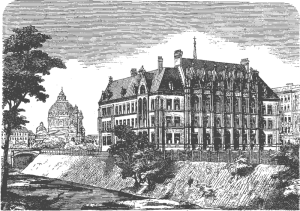
Weiner Akademisches Gymnasium from Moritz Bermann, Alt- und Neu-Wien: Geschichte der Kaiserstadt und ihrer Umgebungen (Vienna: U. Hartleben’s Verlag: 1880). Click to enlarge.
Perhaps the most astonishing thing about the debut of this new Goethe was that he was 17 at the time, and he would complete his entire poetic career before he was 25. And in none of the poetry is there any trace of immaturity, confessional egocentrism or mawkish sentimentality. Broch attributed Hofmannsthal’s remarkable poetic maturity to his being a “Wunderkind, wunderschauendes Kind“7 (a prodigy, a marvel-gazing child). Aside from the poetry itself , Broch has only thin biographical evidence to support that conclusion. But what anecdotes he has, he spins into a cultural psychoanalysis which places Hofmannsthal near the turning point of nineteenth century European culture and also explains him in a way that a modernist of Broch’s preeminent rank can empathize with.
Broch sees the formation of Hofmannthal’s character take place in the 1880s (when Hofmannsthal was 6-15). Broch finds significant that Hofmannthal was an introvert at the Wiener Akademisches Gymnasium: “Hofmannsthal the schoolboy kept to himself, courteously to be sure and never offensively, yet consistent with the Wunderkind whose unchildlike nature no longer wishes, indeed is no longer able, to have anything in common with the childishness of his peers.”8 Broch supposes that the von in young Hugo’s surname inspired some awe in his teachers in that solidly burgher school. From the attention given to a social superior, and from the fact that “he was mentally far superior [and] better looking than most of the others” “emerged an exceptionality which was justified at least in part but became hypertrophied by young Hofmannrthal’s childlike sensibility and thus burdened his still too weak shoulders with an all too heavy burden, all too proud, indeed almost mystical experience.”9
Into this rarefied air (according to Broch) stepped his father. The elder Hugo Hofmann von Hofmannsthal, lawyer and director of the Wiener Grossbank, filled young Hugo’s head with art, particularly theater. Young Hugo’s father did not see his duty as preparing Hugo for a career. Rather he believed it as necessary to show Hugo the things that made up the full life, and to a wealthy Viennese professional, that meant art, particularly theater and music. Broch contrasts Hugo’s father with the father of another Austrian who would reside for his brief adult life in Vienna:
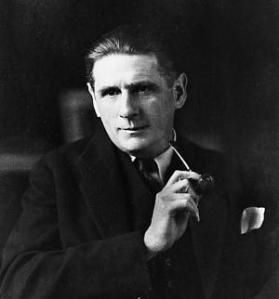
Hermann Broch in 1937, one year before his arrest and then escape from the Nazis. © Österreichischer Bundesverlag, Wien. Click to enlarge.
“The educational influence of Dr. von Hofmann can be compared with the influence Leopold Mozart exerted on his son; the parallel will also show the difference between the two eras. Mozart learned from his father the profession practiced by his father; yet it could hardly have occurred for more than an instant to Dr. Hofmannsthal to prepare his son for the legal profession or, for that matter, for a banking career. He concentrated his guidance far more on imparting Bildung {culture: dkf} and a keen eye [Schaufähigkeit], that is to say, on the development of those abilities through which the leisure hours of the burgher class {the bourgeoisie: dkf} were being transformed to ‘noble enjoyment,’ … Whereas Leopold Mozart wished to bring up his son to be an able musical craftsman and held all other worldly conduct as self-evident and needy of no individual prescription, it was the opposite with Hofmannsthal. His father abstained from any direct interference in the son’s choice of vocation, yet he would certainly have considered it an insult if his son had not followed in his world view. Both Leopold Mozart and Hugo von Hofmann acted ‘morally,’ each in his way; both found reward for their efforts in the genius of the objects of their education; yet it was the difference between the ethical and the aesthetic that proclaimed itself in the goals of their education, the difference between the Mozartean, active and production-directed ‘ethical morality’ on the one hand, the bourgeois ‘aesthetic morality,’ as it can best be called, on the other; for the latter in essence remains directed toward passive ‘appreciation,’ even when it revolves around an appreciation as noble as that of Hofmannsthal.”10
But these are not the only things resulting in Hofmannsthal’s narcissism. Broch (himself the son of wealthy Viennese Jewish parents, but who converted to Roman Catholicism when he was 23) believed that even the Hofmannsthal family’s rejection of Judaism contributed to young Hugo’s perception of “exceptionality.”
“It is well known that there exists a collective narcissism—the principal instrument of all politics—which expresses itself as group consciousness. … Ruling groups, conquering peoples, stabilized upper classes, in short, all who have become ‘style-setting’ exude an ‘aesthetic’ pride, a pride in the specific, corporal ‘beauty’ of the gr0up … In the case of ‘subjected’ peoples, however, it is somewhat more complicated. They assimilate the style of the national, economic, or however-defined upper class in order to take part in the latter’s narcissism, which is meanwhile compounded by the pride of successful assimilation; hence their one-time humiliating situation can never be forgotten. All assimilated minorities reveal this curious ‘two-tiered’ narcissism, fundamentally a mechanism of overcompensation, yet one that does not eliminate the original sense of inferiority but endeavors to conserve it as a springboard for the joy of compensation. Not only does this type of narcissism in assimilated … minorities surpass that of the upper class; it is, moreover, a throughly knowing self-irony, which the ruling class totally lacks. In this manner the strange ‘inner anti-Semitism’ of assimilated Jewry is a phenomenon of ‘two-tiered narcissism.’ Even after an assimilation achieved through the course of several generations, a ‘nobly isolated’ externality is held onto (if only in the twilight of unconsciousness); and the milieu of assimilation, long familiar as a homeland, is seen through a psychic distance that turns it into something foreign. The assimilated individual thus perceives himself as a chosen one of high degree, a chosen one among the chosen people.”11
So it seems that Hofmannsthal’s narcissism was overdetermined (just as Freud would say that hysteria or the content of dreams were overdetermined). So what conclusion does Broch draw from this evidence for narcissism? Broch believes (based on Hofmannsthal’s “most mature work” (The Tower)) that he had long resented the “bourgeois aesthetic” with which he had been instilled:
“It is clear that already as a child he was led to suffering and confusion by the gap in his education—hedonistic or, at the very least, hedonoid aestheticism alongside morality. This narcissistic, exaggerated set of problems would have been insoluble had the guardian angel of genius not arisen and found the solution. The solution was that of dreams, of the fairy tales embedded in dreams.”12
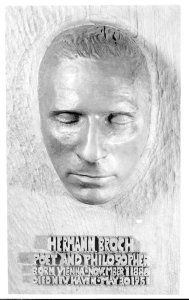
Death mask of Hermann Broch. Beinkie Library, Yale University.
Hofmannsthal’s life-long use of dream motif was Broch’s principal connection with a man who he otherwise had little interest in. When Broch was first asked to provide the introductory essay to a collection of Hofmannsthal’s writing, he accepted only because he had no other position (his hoped for job at Princeton never materialized). He thought of the project as “financing 1948,” but otherwise found the prospect “repulsive.”13 Broch was living in New Haven trudging away at his “life work,” a study, which he began in 1941, entitled Mass Psychology which attempted to explain the popular appeal of totalitarianism by means of a social psychology rooted in a version of Freudianism (or at least using basic Freudian concepts). Broch’s interest in social psychology pre-dated his own fiction (he published articles first stating his theory of cultural values during and right after World War I). His view of the value of (indeed the morality of) art drastically changed over his life. When he wrote the Hofmannsthal essays, he had concluded that literature no longer provided the means to examine the ethical basis of our time. Nevertheless, his two major novels (which attempted such a task), both relied on dream concepts for their organization, narrative and message. The Sleepwalkers used unconscious sleep state as the unifying concept of the three novels. The Death of Virgil, completed only after he had escaped the Nazis, is an elaborate dream-hallucination rumination of the meaning of life and art on the Roman poet’s last day. The unconscious life made evident through dreams thus informed all Broch’s works in all the disciplines he attempted. But is his explanation of Hofmannsthal’s dream poetry valid?
The brief biography he gives can of course be interpreted many ways. The use of later theater works to explain young Hugo’s childhood psychology is not outlandish. Freud used the fiction of writers to explain their own psychic makeup, usually coming to conclusions at odds with biography, however. Broch’s attempt is at least as good as Freud’s. But does psychology say anything more than the writing itself suggests, and, if not, what purpose does it serve?

Portrait of Arthur Schnitzler, Atelier Madame d’Ora, 1915. (ONB/Vienna.)
A simpler explanation of Hofmannsthal’s literary career is probably the one Broch held before wrestling with Hofmannsthal in the context of nineteenth century literary culture: Hofmannsthal’s goal was to distinguish himself in the literary tradition most favored by the ancient aristocracy, solely because it was so favored by them. Let’s consider some additional biographical facts. First, Hofmannsthal proved himself to be politically highly conservative. This is shown by the significant fact (omitted in Broch’s essays) that during World War I Hofmannsthal not only held a position in the ministry supporting the Emperor, he also actively supported the Emperor’s war efforts with various propaganda efforts. None of the Jung-Wein and certainly none of the avant-garde displayed anything like this level of identification with imperial Austria. (Broch himself, who was managing his father’s textile manufactures and presumably would have had more economic interest in defending the existing order, took no such actions. He spent the war working with the Austrian Red Cross.) In the pre-war years Hofmannsthal’s works found acceptance by Richard Strauss and other conservatives. The New Music composers, who used verses by Stefan George (and even poets like Maeterlinck, who were less progressive from a literary point of view than Hofmannsthal) never used Hofmannsthal’s poems. Moreover, Hofmannsthal did not simply acquiesce in the conversion of his grandfather to Catholicism: His wife, though Jewish, converted to Catholicism before she married Hofmannsthal. Schnitzler was openly critical of Hofmannsthal’s rejection of his ethnic Judaism. Finally, Hofmannsthal’s own father’s inculcation of young Hugo with things aesthetic was not the “moral” duty of the upper bourgeoisie; if that were the case surely there would have been examples of others. It seems rather that it was the calculated attempt to have young Hugo regain the aristocratic prestige of the family, which faded when Hugo’s grandfather lost the family fortune in the crash of May 1873 and the subsequent Long Depression. Professor Schorske noted how the aristocracy in those days refused to admit to the life of the imperial court those who won a patent of nobility. “Direct social assimilation to the aristocracy occurred rarely in Austria.” Money itself (of which the Hofmannsthals no longer had much) was itself not sufficient.
“But assimilation could be pursued along another, more open road: that of culture. This too had its difficulties. The traditional culture of the Austrian aristocracy was far removed from the legalistic, puritanical culture of both bourgeois and Jew. Profoundly Catholic, it was a sensuous, plastic culture. Where traditional bourgeois culture saw nature as a sphere to be mastered by imposing order under divine law, Austrian aristocratic culture viewed nature as a scene of joy, a manifestation of divine grace to be glorified in art. Traditional Austrian culture was not, like that of the German north, moral, philosophical, and scientific, but primarily aesthetic. Its greatest achievements were in the applied and performing arts: architecture, the theater, and music.”14
The conflict was not between ethics and aesthetics; it was between Jewish bourgeoise ethically informed aesthetics and aristocratic Catholic aesthetics. Hofmannsthal chose aristocratic aesthetics, but to the extent his bourgeois ethical-aesthetics could not be repressed, it was cast in dreamlike form.
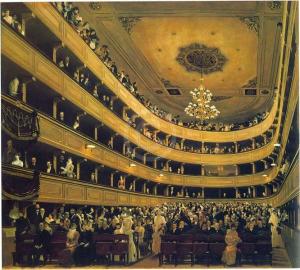
Klimt not only painted the classical theater scenes to decorate the new Burgtheater, he showed the audience of the old one. Aristocrats clamored for special sittings to be immortalized as patrons of the theater. (Shorske at 212 n.*.) The Auditorium of the Old Burgtheater. Oil on canvas by Gustav Klimt (1888) (Historisches Museum der Stadt Wien, Vienna).
Of course Hofmannsthal’s rejection of social naturalism was unlikely to have been motivated by the same reason Broch himself would later reject it: its exhaustion as a form and its inability to speak to fundamental “ethical” questions. (Broch spends a great deal of effort in the first of his Hofmannsthal essays explaining his view of the history of European literary and visual art from the middle of the nineteenth century to Joyce and Kafka. The discussion is very dense and like German writing since Kant depends on the juxtaposition of opposites and their resolution. Neither Marx nor Nietzsche had been able to root out Hegel in Broch’s mental structure. I distill one strand of his thought without attempting to replicate the subtlety of his reasoning.) An aspiring aristocrat like Hofmannsthal could hardly help himself advance his cause by producing novels like Zola’s (or even those of the arch-conservative Dostoevsky for that matter, who was at least as anti-Semitic as the Austrian aristocrats, although perhaps not quite as much as the Christian Socialists whose popularity among the petite bourgeoisie rose to the mayoralty in 1897 Karl Leuger, a man later praised in Mein Kampf).
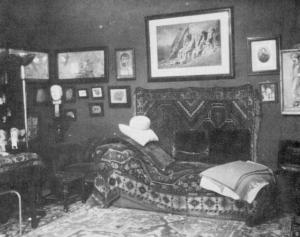
Freud’s consulting room at Berggasse 19, Vienna. (One of the clandestine photographs by Edmund Engelmund in 1938.)
So the imperial theater was the preferred way to regain aristocratic prestige, and that was Hofmanntsthal’s aim from early on (he wrote verse dramas even while producing lyrical poems for the Jung-Wein). He used dream-motivs in his poems and plays, not because it was the inspiration of the personification of some psychic savior, but because dreams were everywhere in fin-de-siècle Vienna. They were the medium of transcendence and constituted the essence of psychic life. The Hofburgtheater itself was not simply the nobility’s metaphor of a dream, but it was itself, in its own national repertory, composed of dream. Austria’s greatest playwright was Franz Grillparzer, a Romantic so imposing that his oratorio graced Beethoven’s funeral. Gillparzer’s masterpiece, Der Traum, ein Leben (“A Dream, a Life”), was based on the seventeenth century play from Spain’s Golden Age, La vida es sueño (“Life is a Dream”) by Pedro Calderón de la Barca, the existential drama often compared with Hamlet. Hofmannsthal undoubtedly saw the play as a young boy. Even if he did not, clearly he studied Grillparzer (and his immediate disciples) because Gillparzer is the link between Hofmannsthal and Goethe both in the selection of dramatic material, the artistic view of the material and the nature of the verse used in the dramas. “As Goethe introduced modern characterization into the story of Iphigenia, Grillparzer followed with his plays on Hero and Leander, Sappho, and Medea.”15 In all of these, the psychology of the actors were examined. Hofmannsthal would follow with his own examinations of classics, the most notable being Elektra. His close reading of Grillprazer led him to publish in 1915 a collection of Grillparzer’s poems: Grillparzers politisches Vermächtnis (Leipzig : Insel-Verlag, [1915]). In his study of Grillparzer, Hofmannsthal could hardly have ignored Grillparzer’s great attachment to Calderón. Hofmannsthal himself explored the relation of life and dreams and dreaming from early on, and their equation is found in much of his lyrical poetry. (See, for example, “Leben, Traum, und Tod,” “Life, Dream and Death.”)
Dreams were not confined to theater in the last decade of the nineteenth century in Vienna, however. Freud’s Interpretation of Dreams was published in 1899. Broch’s own fascination with dreams as both metaphor and entrance to unconscious both in literature and in his social psychology work stemmed from Freud’s work and techniques. Freud himself was undoubtedly guided in his own thinking by the dreams that were everywhere in Vienna, but that is for another story.
* * *
That Hofmannsthal was goaded by ambition (isn’t ambition the very lifespring of the burgher?) and that the dream life of Hofmannsthal’s poems were not dictated by the Angel of Genius does not mean that the works are trivial. They are immediately arresting, but at the same time are composed with a subtlety that bears careful analysis. The poem today illustrates these points.
The poem is named for its form: the terza rima. This form, perfected, if not invented by Dante for the Divine Comedy, is made up of three-lines stanzas where the first and third lines rhyme. The second line rhymes with the first and third lines of the next stanza, so on until the end. In this poem Hofmannsthal doesn’t interlock the stanzas in the first part, but does rhyme the first and third lines. In the final three parts the stanzas are interlocked.
The dream of the poem is created by the simple language (a child’s?) describing familiar objects in odd settings or described with in a way to emphasize their strangeness. The dog in the first part is alien (fremd) because it is (permanently?) silent. This inability to speak, voicelessness, is repeated twice more in different visions. Both times it adds to the strangeness of the image. Inability to express oneself and the inadequacy of language became central themes in Hofmannsthal’s later works. Indeed, his famous Lord Chandos Letter published at about the time that Hofmannsthal concludes his lyric poetry career but before he committed himself entirely to the stage, tells the story of an Elizabethan writer who has “lost completely the ability to think or speak of anything coherently.” Nearly two decades later, in 1921, the main character in his play The Difficult Man (Der Schwierige (Berlin: S. Fischer: 1922)) concludes that language is not merely useless but improper in the face of the enormity of the human condition:
“Everything one utters is indecent. Merely to put anything into words is an indecency. And when one looks at it closely, my dear Aldo, except that men never look closely at anything in the world, there is something positively shameless in our daring even to experience some things.”
Everything has a strangeness, no matter how familiar. It is the nature of the “Thing.” Each Thing whether a mute dog or the full moon over the tree tops is “an uninterpretable interpretability” (as he writes in his Buch der Freunde (Leipzig: Insel-Verlag: 1922). We can understand the Thing without being able to explain it. Everyone confronts external reality, and our only connection with it is the Dream.
The content of the poem (its “ethical” component in Broch’s language) suggests that the transience of life is not, as Hofmannswaldau saw it, the end of things beautiful and precious, but rather in their transformation into other Things. What relieves us of despair is the knowledge of our connection with some others by descent and all other things by physical action, like the fertilizing power of the martyr’s blood. While we may not comprehend it, Life itself is fully aware of its own logic and power.
Terzinen
Über Verganglichkeit
from Gedichte
(Leipzig: Insel-Verlag: 1922)
by Hugo von Hofmannsthal
I
Noch spür ich ihren Atem auf den Wangen:
Wie kann das sein, daß diese nahen Tage
Fort sind, für immer fort, und ganz vergangen?
Dies ist ein Ding, das keiner voll aussinnt,
Und viel zu grauenvoll, als daß man klage:
Daß alles gleitet und vorüberrinnt
Und daß mein eignes Ich, durch nichts gehemmt,
Herüberglitt aus einem kleinen Kind
Mir wie ein Hund unheimlich stumm und fremd.
Dann: daß ich auch vor hundert Jahren war
Und meine Ahnen, die im Totenhemd,
Mit mir verwandt sind wie mein eignes Haar,
So eins mit mir als wie mein eignes Haar.
II
Die Stunden! wo wir auf das helle Blauen
Des Meeres starren und den Tod verstehn,
So leicht und feierlich und ohne Grauen,
Wie kleine Mädchen, die sehr blaß aussehn,
Mit großen Augen, und die immer frieren,
An einem Abend stumm vor sich hinsehn
Und wissen, daß das Leben jetzt aus ihren
Schlaftrunknen Gliedern still hinüberfließt
In Bäum’ und Gras, und sich matt lächelnd zieren
Wie eine Heilige, die ihr Blut vergießt.
III
Wir sind aus solchem Zeug, wie das zu Träumen,
Und Träume schlagen so die Augen auf
Wie kleine Kinder unter Kirschenbäumen,
Aus deren Krone den blaßgoldnen Lauf
Der Vollmond anhebt durch die große Nacht.
… Nicht anders tauchen unsre Träume auf,
Sind da und leben wie ein Kind, das lacht,
Nicht minder groß im Auf- und Niederschweben
Als Vollmond, aus Baumkronen aufgewacht.
Das Innerste ist offen ihrem Weben,
Wie Geisterhände in versperrtem Raum
Sind sie in uns und haben immer Leben.
Und drei sind Eins: ein Mensch, ein Ding, ein Traum.
IV
Zuweilen kommen niegeliebte Frauen
Im Traum als kleine Mädchen uns entgegen
Und sind unsäglich rührend anzuschauen,
Als wären sie mit uns auf fernen Wegen
Einmal an einem Abend lang gegangen,
Indes die Wipfel atmend sich bewegen
Und Duft herunterfällt und Nacht und Bangen,
Und längs des Weges, unsres Wegs, des dunkeln,
Im Abendschein die stummen Weiher prangen
Und, Spiegel unsrer Sehnsucht, traumhaft funkeln,
Und allen leisen Worten, allem Schweben
Der Abendluft und erstem Sternefunkeln
Die Seelen schwesterlich und tief erbeben
Und traurig sind und voll Triumphgepränge
Vor tiefer Ahnung, die das große Leben
Begreift und seine Herrlichkeit und Strenge.
Terzas Rimas
On the Transitory
[translated by DK Fennell]
I
Still yet I feel their breathing on my cheeks:
So how is it that these quite recent days
Are gone, forever gone, and wholly lost?
This is the thing that no one clearly sees,
And much too full of horror to lament:
That all there is slips by, then goes away,
That everything I am, without restraint
Is emanated from a little child
Unnatural as a silent, foreign hound.
And more: I lived a hundred years ago,
And all my forbears (long now wrapped in shrouds),
Relate to me just as my very hair,
Are one with me just as my very hair.
II
And oh the hours! When we on sun-lit blue
At sea observe and comprehend our death
So light, so free of care, without the least despair,
Like little girls with striking pallid skin
And big round eyes, and always seeming cold,
Each silent, staring straight ahead at dusk,
And knowing that right now the very life
From out their weary limbs is flowing forth
To trees and grass, to dress them with sad smile
Just like a martyr pouring out her blood.
III
We are from stuff that dreams come from as well,
And dreams have eyes that open in this way:
Like little children under cherry trees,
Along the pallid golden path on top
The waxing moon appears through darkest night.
… No other way do dreams appear to us,
Here they live just like a laughing child,
No less sublime when wafting up and down,
Than is the moon awaking through treetops.
The inner life is open to their plait,
Like phantom’s hands inside a locked up room
They are inside of us and always live.
And three are one: the man, the thing, the dream.
IV
Sometimes the women who were never loved
Appear to us in dreams as little girls,
Unutterably touching to behold,
As though with us upon a distant path
One time at evening quite a while ago,
All while the trees bestir themselves with sighs
And fragrance settles down and night and fears,
Along the path, our very path, unlit,
In evening luster twinkle silent ponds
And, mirror to our longing, dreamlike wink,
And all the gentle words, all things afloat
In evening air as well the first star-gleam
Like sisters do, their souls profoundly shake
And they are sad but full of jubilance
Before an inner thought, that Life Itself
Perceives its very majesty and strength.
* * *
Italian is easier to rhyme than German (and so Dante could complete a three volume epic in (terzas rimas), and German is easier than English, not only because more words and word-forms rhyme, but also because in English it is more difficult to put rhyming words in the end position of lines. I therefore have omitted rhyming here, because otherwise the laconic visions would be disturbed. Compare the rhymed version, as close to literal as the rhyme scheme allowed, by Charles Wharton Stork:16
Of Mutability [Terzinen I].
Still, still upon my cheek I feel their breath:
How can it be that days which seem so near
Are gone, forever gone, and lost in death?
This is a thing that none may rightly grasp,
A thing too dreadful for the trivial tear:
That all things glide away from out our clasp;—
And that this I, unchecked by years, has come
Across into me from a little child,
Like an uncanny creature, strangely dumb;—
That I existed centuries past—somewhere,
That ancestors on whom the earth is piled
Are yet as close to me as my very hair.
As much a part of me as my very hair.
Death [Terzinen II].
What hours are those! when, shiningly outspread,
The ocean lures us, and we lightly learn
The solemn lore of death, and feel no dread:
As little girls, whose great eyes seem to yearn,
Girls that have pallid cheeks and limbs a-cold,
Some evening look far out and do not turn
Their feebly-smiling gaze, for, loosing hold
Upon their slumber-drunken limbs, the flood
Of life glides over into grass and wold;—
Or as a saint pours out her martyr blood.
“Such Stuff as Dreams” [Terzinen III],
Such stuff as dreaming is we mortals be,
And every dream doth open wide its eyes
Like a small child beneath a cherry tree,
Above whose top across the deepening skies
The pale full-moon emerges for its flight.
Not otherwise than so our dreams arise.
They live as a child that laughs, and to the sight
Appear no smaller on their curving way
Than the full-moon awakening on the night.
Our inmost self is open to their sway.
As spirit hands in sealed chambers gleam
They dwell in us and have their life alway.
And three are one: the man, the thing, the dream.
Note on Text: You see that Stork only translates the first three parts of the poem. The reason is that he translated from the 1907 edition of the collected poems of Hofmannsthal, which did not include the fourth part. In fact, I have been unable to find a published version of the fourth part before the 1922 edition (the one I used). The publication history of the poem is somewhat curious. Evidently the first publication was in 1895 in Stefan George’s Blätter für die Kunst (Leaves for Art or Album for Art). The individual issues of this journal were circulated only among a small circle, so I cannot tell what the original version was. But the collected volume for the years 1892-1898, published by Georg Bondi in Berlin in 1899 (entitled: Blaetter fuer die Kunst: Eine Auslese aus den Jahren 1892-98) contains only the first part of the poem (on page 73) under the title “Terzinen über Vergänglichkeit.” That version is the same as Part I above, except for the idiosyncratic orthography of G. Bondi, where nouns are not capitalized, the double s is used instead of the ligature symbol ß, and a general carelessness with commas (although in this version the commas are identical to the version in the 1922 edition). G. Bondi as Verlag der Blaetter fuer die Kunst in Berlin published two editions of the collected poems of Hofmannsthal (Ausgewaehlte Gedichte) in 1903 and 1904. Those versions show the carelessness with the commas (which are represented by a middle dot). The first three parts of the poem are included in these two collections. Thereafter, Insel-Verlag in Leipzig published Hofmannsthal’s collected poems. The following version have only the first three parts (and they use the orthography as in the text above): Die gesammelten Gedichte (1907) (pp. 19-21); Die Gedichte und kleinen Dramen (1911) (pp. 14-15); Die Gedichte und kleinen Dramen (1916, stated to be the 3rd edition) (pp. 14-15); and Die Gedichte und kleinen Dramen (1919, stated to be the fifth edition) (pp. 14-15). I was unable to located either the second or fourth editions, but since the three I did see seemed to use the same plates, it’s unlikely the other two editions differed in any way. The next edition is the one I use, called simply Gedichte on the title page and Die geammelten Gedichte on the succeeding page. The poem is found on pages 26-28. Before this edition the title “Über Vergänglichkeit” is placed under the Roman I. In this edition the title comes first and is the title for the complete four part poem.
Notes
1Charles Wharton Stork (trans. & ed.), The Lyrical Poems of Hugo von Hofmannsthal (Yale University Press: 1918), p. 17. [“Stork”]
2Elisabeth Walter, “Hugo von Hofmannsthal, an Exponent of Modern Lyricism,” Colonnade (December 1916). [“Walter”]
3Stork at 19.
4Walter.
5Hermann Broch, Hugo von Hofmannsthal and his Time: The European Imagination, 1860-1920, translated and edited by Michael P. Steinberg (University of Chicago Press: ©1984), p. 151. [“Broch”]
6J.D. McClatchy, The Whole Diifference: Selected Writings of Hugo von Hofmannsthal (Princeton University Press: 2008), p. 4.
7Broch at 192 n.3.
8Broch at 89-90.
9Broch at 89.
10Broch at 87-88.
11Broch at 90.
12Broch at 91.
13Broch at 4 (Steinberg’s introduction).
14Carl E. Schorske, Fin-De-Siècle Vienna (NY: Viking Books: 1981), p. 7. [“Schorske”]
15Stork at 4.
16Stork at 34-36.









